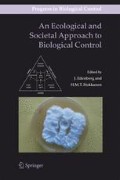Abstract
Biological control is one of several strategies used to control pests to avoid economic damage on crop plants, in husbandry, or on recreation areas. It is also used against nuisance pests. In this chapter, I use the terms ‘pest’ and ‘pests’ for insect, mites and vertebrate pests, plant diseases, and weeds.
Access this chapter
Tax calculation will be finalised at checkout
Purchases are for personal use only
Preview
Unable to display preview. Download preview PDF.
References
Anonymous (2002): IFOAM Basic Standards for Organic Production and Processing, approved by the IFOAM General Assembly, Victoria, Canada, August 2002, Section A-D, 72 pp.
Barbosa, P. (ed.) 1998. Conservation biological control. Acad. Press, San Diego, California, 396 pp.
Carson, R. (1962). Silent Spring. Hamish Hamilton, London
Copping, L.G. (ed.) (1998). The BioPesticide Manual. A World Compendium. British Crop Protection Council, Farnham, UK, 333 pp.
DeBach, P. (ed.) (1964). Biological control of insect pests and weeds. Chapman and Hall, London., 844 pp.
DeBach, P. (1974). Biological control by natural enemies. Cambridge University Press. Cambridge, 323 pp
Driesche, R. van, Bellows, T.S. (1996). Biological control. Chapman and Hall, New York, 539 pp.
Eilenberg, J., Hajek, A., Lomer, C. (2001). Suggestions for unifying the terminology in biological control. BioControl 46: 387–400.
Enkerli, J., Widmer, F., Keller, S. (2004) Long-term field persistence of Beauveria brongniartii strains applied as biocontrol agents against European cockchafer larvae in Switzerland. Biological Control, 29, 115–123.
Gurr, G.M., Barlow, N.D., Memmott, J., Wratten, S.D., & Greathead, D.J. (2000). A history of methodological, theoretical and empirical approaches to biological control. In Gurr, G. & Wratten, S. (eds): Biological control: measures of success. Kluwer Academic Press, Dordrecth, 3–37.
Hajek, A. (2004). Natural Enemies. An Introduction to Biological Control. Cambridge University Press, Cambridge, 378 pp.
Jetter, K., Payne, T.D. (2004). Consumer preferences and willingness to pay for biological control in an urban landscape. Biological Control, 30, 312–322.
Landis, D.A.; Wratten, S.D. and Gurr, G.M. 2000. Habitat management to conserve natural enemies of arthropod pests in agricultulture. Ann.Rev.Entomol, 45, 175–201.
Lenteren, J. van (2000). A greenhouse without pesticides: fact or fantasy? Crop protection, 19, 375–384.
Letourneau, D.K. (1998). Conservation biology: lessons for conserving natural enemies. In Barbosa, P. (ed.): Conservation biological control, Academic Press, San Diego, 9–38.
Malais, M.H., Ravensberg, W.J. (2003). Knowing and recognizing. The Biology of Glasshouse Pests and their natural Enemies. Reed Business Information, Doetinchem, The Netherlands, 228 pp.
Perkins, J.H.; Garcia, R. (1999). Social and economic factors affecting research and implementation of biological control. In Bellows, T.S. and Fisher, T.W. (eds.): Handbook of Biological Control, Academic Press, San Diego, 993–1009.
Pickett, C.H., Bugg, R.L. (eds.) (1998) Enhancing Biological Control. University of California Press, Berkeley, 422 pp.
Waage, J.K. (2001). Indirect ecological effects in biological control: the challenge and the opportunity. In Wajnberg, E., Scott, J.K. and Quimby, P.C. (eds.): Evaluating indirect ecological Effects of Biological Control. CABI Publishing, Wallingford, 1–12.
Editor information
Editors and Affiliations
Rights and permissions
Copyright information
© 2006 Springer
About this chapter
Cite this chapter
Eilenberg, J. (2006). CONCEPTS AND VISIONS OF BIOLOGICAL CONTROL. In: EILENBERG, J., HOKKANEN, H. (eds) An Ecological and Societal Approach to Biological Control. Progress in Biological Control, vol 2. Springer, Dordrecht. https://doi.org/10.1007/978-1-4020-4401-4_1
Download citation
DOI: https://doi.org/10.1007/978-1-4020-4401-4_1
Publisher Name: Springer, Dordrecht
Print ISBN: 978-1-4020-4320-8
Online ISBN: 978-1-4020-4401-4
eBook Packages: Biomedical and Life SciencesBiomedical and Life Sciences (R0)

